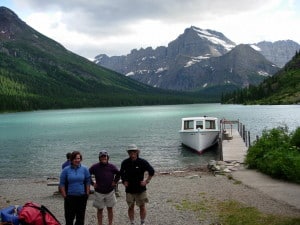What: We will be working on reconstructing past environmental and geomorphic conditions in Glacier National Park through collection and analysis of lake sediment cores. There is broad interest in the future of our National Park system, particularly Glacier National Park, which is sensitive to climate change through glacial retreat and ecosystem adjustments. This research project is aimed at understanding environmental and climate change in a near-pristine alpine basin in North America, and we will collect data that is very relevant to the debate about climate change in the northern U.S. Rockies since the Last Glacial Maximum.

Where: 10-days of fieldwork in Glacier National Park, Montana, plus 2 weeks of labwork at the LacCore Lab and Limnological Research Center at the University of Minnesota, Twin Cities
Who: A team of 6 students, Professor Kelly MacGregor from Macalester College, and Dr. Amy Myrbo from the LacCore Laboratory, University of Minnesota

In summer 2014 we plan to collect a long core from Swiftcurrent Lake close to the Many Glacier Hotel (in Swiftcurrent Lake), as well as a transect of cores in Lake Josephine to help us meet several research goals: 1) further examine the relationship between glacial/geomorphic forcing and the resultant lacustrine sedimentary record in an alpine landscape; 2) provide enhanced spatial resolution of dolomite transport in the proglacial hydrologic system to enhance our understanding of the temporal lags of sediment within the system and to quantify the relationship between erosion and lake sedimentation; and 3) assess the human impacts on the watershed through collection and dating of near-surface sediments.
In addition to the millennial timescale questions that can be addressed through lake cores, we are interested in examining recent environmental change in the Many Glacier area. Changes in glacier size, hydrology, ecology, and the human footprint in the Park is relatively well documented, and surface cores (which are easy to collect across a wide area of Swiftcurrent Lake) would provide excellent spatial controls on changing sedimentation in the basin.
Student projects: There are a wide range of possible student projects, depending on the expertise of the students and the lab facilities at their home institutions. Possible projects include:
- Lake core analyses:
- Several projects could be done on the ~30 meters of core we collected from lower Grinnell Lake, Swiftcurrent Lake and Fishercap Lake in 2010, in the event few cores can be collected during the field season (or if a student or two is interested in the entire Holocene record). Charcoal analysis to constrain fire frequency and history could be done in these lakes, along with pollen studies and diatom analysis.
- Carbon/Nitrogen ratios: C/N analyses document the source of organic material in lake sediments. A study could build on previous work to look at the relative importance of algae to terrestrial carbon in the various lakes. Collections of vegetative material (rooted aquatic plants, terrestrial plant, algal aquatic material) would be sampled and analyzed to better constrain the C/N data.
- Analysis of near-surface cores (the top 20-70 cm of sediment) to examine evidence of human impacts on the basin (including the building and renovation of the Many Glacier Hotel), changes in modern/historical sediment transport in a given lake, and/or sedimentation rates and erosional patterns
- Core analyses that would provide key information regarding changes in the lake environments: age models (sampling and analysis using cesium-137 and/or lead-210), color analysis (we have demonstrated this has great potential for quantifying dolomite concentration in Swiftcurrent Lake), grain size analyses, coulometry, and XRD.
- Dolomite tracer projects: Previous work suggests dolomite (present only beneath Grinnell Glacier and along the Continental Divide) can be used as a proxy for glacier size (MacGregor and others, 2011; Schachtman and others, 2013; Anderson and others, 2013). However, we do not fully understand the role that upstream lakes may play in filtering dolomite along its transport path. A detailed analysis of dolomite presence over time in a downstream transect of cores (both within Lake Josephine and comparing lower Grinnell Lake, Lake Josephine and Swiftcurrent Lake) would provide important details about dolomite transport and deposition. In addition, the grain size of dolomite as compared to the quartz and chlorite/illite fraction in the sediments needs to be investigated to model grain transport.
- Mapping of rock outcrops and XRF analysis: Preliminary XRF work shows a simple but interesting elemental signature of the different rock types present in the valley. Within the lake sediments, we posit that dolomite appears to be sourced only by glacial erosion and headwall processes, whereas the clastic fraction appears to be produced by hillslope processes such as landslides, avalanches, and creep. However, the bedrock geologic map of the valley is quite coarse, and further investigation of the major and minor constituents in the geologic units is needed to provide constraints for a possible sediment mixing model. A mixing model could provide important controls on the source and geomorphic delivery mechanisms for lake sediment in the valley, allowing us to use lake cores as a tool for understanding key geomorphic forces in the valley.
- Several projects could be done on the ~5 meters of core we collected from lower Grinnell Lake in 2010. The cores showed stochastic deposition (fine grained sedimentation punctuated by sandy landslide layers), but only the top ~1 m of core has been examined in detail. Charcoal analysis to constrain fire frequency and history could be done, along with pollen studies and diatom analysis.

Course Preparation: Prerequisites are sedimentology and/or geomorphology, with mineralogy a plus. In addition, the students should have outdoor experience, comfort with boating, the ability to swim, and the willingness to live in close quarters while we are staying at Glacier National Park.
Contact information: Professor Kelly MacGregor (Project Director) at macgregor@macalester.edu

